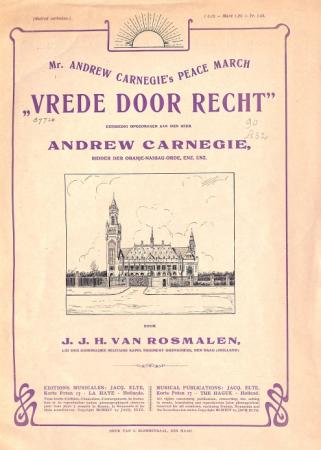A long-lost march by the Dutch composer J.J.H. van Rosmalen has been rediscovered here at the Library, a century after its creation in 1914. The two-page score is a short festive march in honour of Andrew Carnegie, steel magnate and philantropist. The Peace Palace, officially opened on 28 August 1913, was built with his extraordinary gift of 1,500,00 million dollars.
A long-lost march by the Dutch composer J.J.H. van Rosmalen has been rediscovered here at the Library, a century after its creation in 1914. The two-page score is a short festive march in honour of Andrew Carnegie, steel magnate and philantropist. The Peace Palace, officially opened on 28 August 1913, was built with his extraordinary gift of 1,500,00 million dollars.
Mr. Andrew Carnegie's Peace March "Vrede door recht" ["Peace through Law"] eerbiedig opgedragen aan den heer Andrew Carnegie, ridder der Oranje-Nassau-orde, enz. enz. door J.J.H. van Rosmalen, lid der Koninklijke Militaire Kapel Regiment Grenadiers, Den Haag (Holland).
Musical Publications: Jacq. Elte, Korte Poten 17, The Hague, Holland. Copyright MCMXIV by Jacq. Elte. Druk van C. Blommendaal, Den Haag.
This remarkable piece of music for piano was unknown to Heleen van der Weel, carillonneur of the Peace Palace. She will adapt the music score for the Peace Carillon, installed in 1994 in the main tower. This carillon - 47 bells - is a concert instrument. Weekly concerts are given on Tuesday and Thursday from 13.00 - 13.45 pm.
Andrew Carnegie and the Peace Palace
The life story of Andrew Carnegie (1835-1919) is a classic example of ‘The American Dream’. Carnegie was born in a simple working class family in Scotland, but migrated to the United States with his family in search of a better life. There he worked his way up from bobbin boy to successful entrepreneur. He soon started his own steel company and eventually managed to create an enormous imperium. In 1901 he sold Carnegie Steel Company for the then astounding amount of 480 million dollars. Carnegie wished to spend the remainder of his life working towards his vision, by responsibly spending his capital. He felt he had an obligation to the society that had offered him so many chances. He saw many opportunities to advance society. According to the philanthropist, science, education and peace were the most important conditions for progress.
Carnegie became convinced of the importance of a palace for peace and offered a donation of no less than 1.5 million dollars. He made his donation under the condition that the Peace Palace would not only house the Permanent Court of Arbitration, but also a public legal library of the highest standard. In 1904 the Carnegie Foundation was founded to administer the funds and manage the construction of the Peace Palace. This foundation today still is owner and manager of the building, a recognized national monument. The foundation also stimulates the organization of seminars and other initiatives that foster the peace ideal and is a member of the international philanthropic network of Carnegie-institutes.
